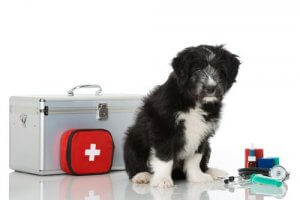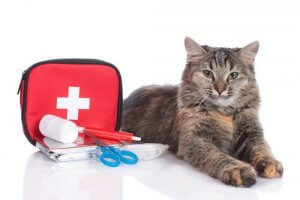How to Make a First Aid Kit for Your Pet


Written and verified by the biotechnologist Alejandro Rodríguez
Prevention is always better than cure, and caring for pets is no exception. However, they’re inevitably going to get sick or injured at some point, and having something as simple as a first aid kit can be a quick and effective way to treat minor illnesses and injuries.
Why is it important to have a first aid kit?
As we’ve already mentioned, accidents happen, whether at home or outside the house. Our pets are exposed to a variety of different situations over the course of the day, some of which can pose a danger to their health. These include:
- Cuts. These can occur inside or outside the house. Depending on how serious they are, your pet might suffer significant bleeding.
- Burns
- Bites: whether by accident, or in a fight with another animal.
- Choking, indigestion or poisoning
- Falls or breaks

In many of these situations, a first aid kit will be your greatest ally. However, it’s important to remember that it is in no way a substitute for an actual vet. What’s more, we would recommend making sure that all of the items you buy for your first aid kit are approved by a vet, especially when it comes to pharmaceutical products.
First aid kits for pets: the essentials
Every basic first aid kit needs to contain the following items:
- Latex gloves: for hygiene purposes
- Gauze, surgical tape and bandages: very useful for cuts, grazes and larger wounds
- Saline solution: to clean cuts and the area around the eyes
- Scissors
- Rectal thermometer
- Creams: useful for treating bites and allergic reactions. These products can usually be obtained after consultation with a vet.
With these basic items, you’ll be able to deal with many of the most common minor injuries, either to cure them completely, or to provide basic care until you can get to a vet.

Additional items for your first aid kit
There are several other items that you might find useful for your first aid kit. These are more specific, and are more useful for some animals than others. These include:
- Special tweezers for removing ticks
- Nail clippers
- Ear cleaning fluid – this is particularly useful for dogs
- Paw protectors, in case your pet suffers an allergic reaction or another injury to its paws
- Emetics: particularly useful in the case of poisoning
- Antiparasitics: as well as protecting your pet with flea collars or pipette treatments, having an extra collar or an antiparasitic spray is a good idea
Some final advice
As we’ve already mentioned, it’s important to consult with a vet to make sure all the items in your first aid kit are suitable for your pet. To ensure you can get to it easily, be sure to keep it in a place that’s safe, but easy to remember and access.
Having a well-ordered first aid kit will help you find things more quickly. You could use a box or small case with different compartments so you can organize the items properly. Having a second travel kit is also a good idea.
Always ensure the contents of your first aid kit are in date before you use them. Checking this regularly is essential when it comes to medical products, whether topical or oral. And last, but definitely not least, always make sure you have a list of emergency phone numbers close to hand.
Prevention is always better than cure, and caring for pets is no exception. However, they’re inevitably going to get sick or injured at some point, and having something as simple as a first aid kit can be a quick and effective way to treat minor illnesses and injuries.
Why is it important to have a first aid kit?
As we’ve already mentioned, accidents happen, whether at home or outside the house. Our pets are exposed to a variety of different situations over the course of the day, some of which can pose a danger to their health. These include:
- Cuts. These can occur inside or outside the house. Depending on how serious they are, your pet might suffer significant bleeding.
- Burns
- Bites: whether by accident, or in a fight with another animal.
- Choking, indigestion or poisoning
- Falls or breaks

In many of these situations, a first aid kit will be your greatest ally. However, it’s important to remember that it is in no way a substitute for an actual vet. What’s more, we would recommend making sure that all of the items you buy for your first aid kit are approved by a vet, especially when it comes to pharmaceutical products.
First aid kits for pets: the essentials
Every basic first aid kit needs to contain the following items:
- Latex gloves: for hygiene purposes
- Gauze, surgical tape and bandages: very useful for cuts, grazes and larger wounds
- Saline solution: to clean cuts and the area around the eyes
- Scissors
- Rectal thermometer
- Creams: useful for treating bites and allergic reactions. These products can usually be obtained after consultation with a vet.
With these basic items, you’ll be able to deal with many of the most common minor injuries, either to cure them completely, or to provide basic care until you can get to a vet.

Additional items for your first aid kit
There are several other items that you might find useful for your first aid kit. These are more specific, and are more useful for some animals than others. These include:
- Special tweezers for removing ticks
- Nail clippers
- Ear cleaning fluid – this is particularly useful for dogs
- Paw protectors, in case your pet suffers an allergic reaction or another injury to its paws
- Emetics: particularly useful in the case of poisoning
- Antiparasitics: as well as protecting your pet with flea collars or pipette treatments, having an extra collar or an antiparasitic spray is a good idea
Some final advice
As we’ve already mentioned, it’s important to consult with a vet to make sure all the items in your first aid kit are suitable for your pet. To ensure you can get to it easily, be sure to keep it in a place that’s safe, but easy to remember and access.
Having a well-ordered first aid kit will help you find things more quickly. You could use a box or small case with different compartments so you can organize the items properly. Having a second travel kit is also a good idea.
Always ensure the contents of your first aid kit are in date before you use them. Checking this regularly is essential when it comes to medical products, whether topical or oral. And last, but definitely not least, always make sure you have a list of emergency phone numbers close to hand.
All cited sources were thoroughly reviewed by our team to ensure their quality, reliability, currency, and validity. The bibliography of this article was considered reliable and of academic or scientific accuracy.
- Navarro, A. A., & Peralta, P. D. (2010). Disponibilidad, prescripción y uso racional de medicamentos de uso veterinario (II). Albéitar: publicación veterinaria independiente, (137), 34-35.
- Li, S. (2007). Manual para botiquines veterinarios.
This text is provided for informational purposes only and does not replace consultation with a professional. If in doubt, consult your specialist.








